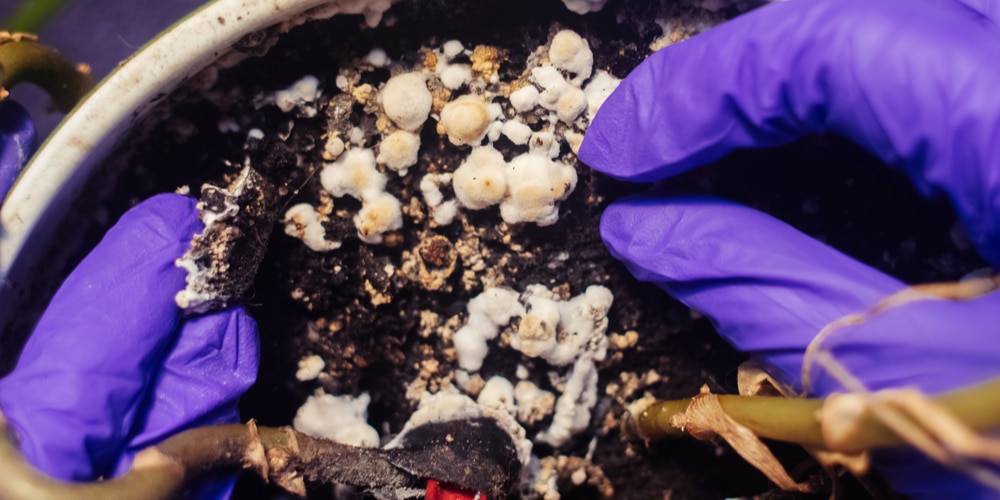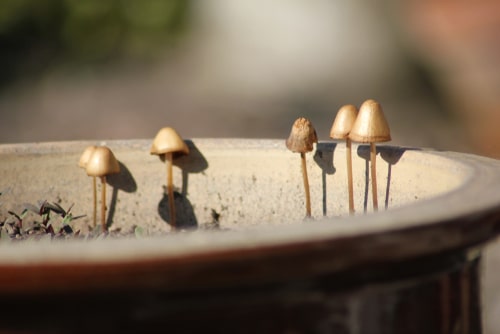Growing houseplants might be demanding. Some need more care than others. However, when you learn about their needs and requirements (and meet them), you should have no issues decorating your interiors with gorgeous plants.
Unfortunately, things don’t always go as you plant them. Houseplants might attract infections, diseases, and pests. Sometimes, you might even notice mushrooms growing in potted plants. And that might be a frustrating sight (we understand it!)
But if that happens to you, don’t worry! In this essential guide, we included everything you should know about mushrooms growing near your houseplants (and how to remove them)!
Why Are There Mushrooms in Your Houseplant Potting Mix?
The sight of mushrooms in your houseplants’ potting mix might surprise you. However, it is not as uncommon as you might think. As you may expect, the presence of mushrooms (usually yellowish or white) indicates the infestation of a fungus.
Usually, the cause of the development of mushrooms around your houseplant is inadequate watering. They will most likely form in warm climates (especially if your soils are rich).
Additionally, if you have been growing plants for a while, you should know that too much moisture will often cause problems. For instance, it will attract fungal infections.
Sometimes, the appearance of mushrooms indicates deeper issues (such as root rot) which are often the results of high humidity or soggy soil. For this reason, choosing a suitable potting mix for your plants is imperative for their health.
While the mushrooms that will form in your houseplant potting mix will rarely be poisonous, they will ruin your interiors’ aesthetics. And if they like the environment, they will spread fast.
But luckily, they won’t deprive your plants of nutrients (more on this later). Still, we recommend you take action to remove them as soon as they appear. Of course, you should never eat mushrooms growing in your houseplant potting mix.
How to Get Rid of Mushrooms Growing in Houseplant Soil?
As we mentioned, mushrooms growing in houseplant soil do not pose a significant threat to your plants. Sometimes, it might even help their growth (when they are not a symptom of root rot).
However, we recommend you remove them to prevent further issues. You can pluck them with your hands as soon as they appear. However, don’t forget that the spores might be invisible, making it more challenging to remove them.
Still, you can take measures to prevent them from developing in the future. For instance, you should avoid leaving the soil too wet. If you think the drainage is good, you might have to move your plant to a sunnier location or change your watering schedule.
Also, ensure you remove decaying matter (such as leaves and roots) as soon as you see them. Indeed, mushrooms will develop around decomposing organic material (which they feed on). Additionally, consider keeping a window open to regulate the plant’s humidity levels.
If the situation bothers you, you might have to use a fungicide. Don’t forget to follow the instructions you find on the product’s label and avoid overdoing it: you may cause more harm than good to your plant. Of course, there are organic solutions too. However, they usually take more time than chemical ones.
What Will Mushrooms do To Your Houseplants?
It is not rare for homeowners to see mushrooms on their houseplants’ pots. In the best-case scenario, they might create a symbiotic relationship that will aid your plants’ growth.
Also, they might help convert organic waste into compost, which will ensure your plants get all the nutrients they need to thrive. However, their presence might indicate a problem with your houseplant.
Take your time to identify the root cause of the presence of mushrooms. Once you understand what might be causing it, consider what you should do about it.
If the problem is too much moisture or inadequate drainage, you should take action to improve your plant’s growing conditions. After all, while mushrooms thrive in moist and humid environments, most plants will struggle and stop producing flowering. At worst, you might be dealing with root rot.
To revert your plants to their natural conditions, consider repotting them in new soil. Never water your green friends when the top 1 to 2 inches don’t feel dry. Doing so might cause severe problems to the development of your plants.
Related Article: Brown Mushrooms Growing in a Potted Plant


